\begin{align*} \lim_{x \to 3}\dfrac{x^2-9}{x+3} &=\lim_{x \to 3}\dfrac{(x-3)(x+3)}{x+3}\\ &=\lim_{x \to 3}(x-3)\\ &=3-3\\ &=\text{0} \end{align*}

|
Previous
End of chapter exercises
|
Next
6.2 Differentiation from first principles
|
Calculus is one of the central branches of mathematics and was developed from algebra and geometry. It is built on the concept of limits, which will be discussed in this chapter. Calculus consists of two related ideas: differential calculus and integral calculus. We will only be dealing with differential calculus in this chapter and will explore how it can be used to solve optimisation problems and finding rates of change.
Zeno (born about 490 BC) was a philosopher of southern Italy who is famous for his paradoxes (a “paradox” is a statement that seems contradictory and yet may be true).
One of Zeno's paradoxes can be summarised as:
Achilles and a tortoise agree to a race, but the tortoise is unhappy because Achilles is very fast. So, the tortoise asks Achilles for a head start. Achilles agrees to give the tortoise a \(\text{1 000}\) \(\text{m}\) head start. Does Achilles overtake the tortoise?
To solve this problem, we start by writing:
\begin{align*} \text{Achilles:} \quad {x}_{A} & = {v}_{A}t \\ \text{Tortoise:} \quad {x}_{T} & = \text{1 000}\text{ m} + {v}_{T}t \end{align*}where
Achilles will overtake the tortoise when both of them have covered the same distance. If we assume that Achilles runs at \(\text{2}\text{ m.s$^{-1}$}\) and the tortoise runs at \(\text{0,25}\text{ m.s$^{-1}$}\), then this means that Achilles will overtake the tortoise at a time calculated as:
\begin{align*} {x}_{A} & = {x}_{T} \\ {v}_{A}t & = \text{1 000} + {v}_{T}t \\ 2 t &= \text{1 000} + \text{0,25}t \\ 2 - \text{0,25}t &= \text{1 000} \\ \frac{7}{4}t &= \text{1 000} \\ t &= \frac{\text{4 000}}{7} \\ &= \text{571,43}\text{ s} \end{align*}However, Zeno looked at it as follows: Achilles takes \(t=\frac{\text{1 000}\text{ m}}{\text{2}\text{ m.s$^{-1}$}}= \text{500}\text{ s}\) to travel the \(\text{1 000}\text{ m}\) head start that he gave the tortoise. However, in these \(\text{500}\text{ s}\), the tortoise has travelled a further \(x = \text{500}\text{ s} \times \text{0,25}\text{ m.s$^{-1}$} = \text{125}\text{ m}\).
Achilles then takes another \(t=\frac{\text{125}\text{ m}}{\text{2}\text{ m.s$^{-1}$}}= \text{62,5}\text{ s}\) to travel the \(\text{125}\text{ m}\). In these \(\text{62,5}\) \(\text{s}\), the tortoise travels a further \(x = \text{62,5}\text{ s} \times \text{0,25}\text{ m.s$^{-1}$} = \text{15,625}\text{ m}\).
Zeno saw that Achilles would always get closer and closer but wouldn't actually overtake the tortoise.
So what does Zeno, Achilles and the tortoise have to do with calculus? Consider our earlier studies of sequences and series:
We know that the sequence \(0;\frac{1}{2};\frac{2}{3};\frac{3}{4};\frac{4}{5}; \ldots\) can be defined by the expression \({T}_{n}=1-\frac{1}{n}\) and that the terms get closer to \(\text{1}\) as \(n\) gets larger.
Similarly, the sequence \(1;\frac{1}{2};\frac{1}{3};\frac{1}{4};\frac{1}{5};\ldots\) can be defined by the expression \({T}_{n}=\frac{1}{n}\) and the terms get closer to \(\text{0}\) as \(n\) gets larger.
We have also seen that an infinite geometric series can have a finite sum.
\[{S}_{\infty }=\sum _{i=1}^{\infty }{a}.{r}^{i-1}=\frac{{a}}{1-r} \quad \text{ for }-1<r<1\]where \(a\) is the first term of the series and \(r\) is the common ratio.
We see that there are some functions where the value of the function gets close to or approaches a certain value as the number of terms increases.
Consider the function:
\(y=\frac{{x}^{2}+4x-12}{x+6}\)The numerator of the function can be factorised as:
\(y=\frac{\left(x+6\right)\left(x-2\right)}{x+6}.\)Then we can cancel the \(x+6\) from numerator and denominator and we are left with:
\(y=x-2.\)However, we are only able to cancel the \(x+6\) term if \(x\ne -6\). If \(x=-6\), then the denominator becomes \(\text{0}\) and the function is not defined. This means that the domain of the function does not include \(x=-6\). But we can examine what happens to the values for \(y\) as \(x\) gets closer to \(-\text{6}\). The list of values shows that as \(x\) gets closer to \(-\text{6}\), \(y\) gets closer and closer to \(-\text{8}\).
|
\(x\) |
\(y=\frac{\left(x+6\right)\left(x-2\right)}{x+6}\) |
|
\(-\text{9}\) |
\(-\text{11}\) |
|
\(-\text{8}\) |
\(-\text{10}\) |
|
\(-\text{7}\) |
\(-\text{9}\) |
|
\(-\text{6,5}\) |
\(-\text{8,5}\) |
|
\(-\text{6,4}\) |
\(-\text{8,4}\) |
|
\(-\text{6,3}\) |
\(-\text{8,3}\) |
|
\(-\text{6,2}\) |
\(-\text{8,2}\) |
|
\(-\text{6,1}\) |
\(-\text{8,1}\) |
|
\(-\text{6,09}\) |
\(-\text{8,09}\) |
|
\(-\text{6,08}\) |
\(-\text{8,08}\) |
|
\(-\text{6,01}\) |
\(-\text{8,01}\) |
|
\(-\text{5,9}\) |
\(-\text{7,9}\) |
|
\(-\text{5,8}\) |
\(-\text{7,8}\) |
|
\(-\text{5,7}\) |
\(-\text{7,7}\) |
|
\(-\text{5,6}\) |
\(-\text{7,6}\) |
|
\(-\text{5,5}\) |
\(-\text{7,5}\) |
|
\(-\text{5}\) |
\(-\text{7}\) |
|
\(-\text{4}\) |
\(-\text{6}\) |
|
\(-\text{3}\) |
\(-\text{5}\) |
The graph of this function is shown below. The graph is a straight line with slope \(\text{1}\) and \(y\)-intercept \(-\text{2}\), but with a hole at \(x=-6\). As \(x\) approaches \(-\text{6}\) from the left, the \(y\)-value approaches \(-\text{8}\) and as \(x\) approaches \(-\text{6}\) from the right, the \(y\)-value approaches \(-\text{8}\). Since the function approaches the same \(y\)-value from the left and from the right, the limit exists.
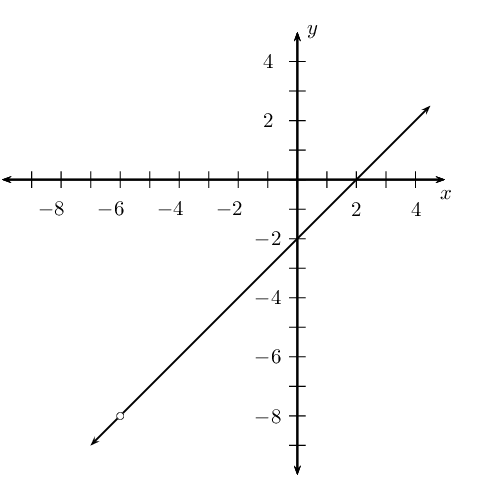
We can now introduce new notation. For the function \(y=\frac{\left(x+6\right)\left(x-2\right)}{x+6}\), we can write:
\[\lim_{x\to -\text{6}} \frac{\left(x+6\right)\left(x-2\right)}{x+6}=-\text{8}.\]This is read: the limit of \(\frac{\left(x+6\right)\left(x-2\right)}{x+6}\) as \(x\) tends to \(-\text{6}\) (from both the left and the right) is equal to \(-\text{8}\).
If \(f\left(x\right)=x+1\), determine:
|
\(f\left(-\text{0,1}\right)\) |
\(\phantom{xxxxxx}\) |
|
\(f\left(-\text{0,05}\right)\) |
|
|
\(f\left(-\text{0,04}\right)\) |
|
|
\(f\left(-\text{0,03}\right)\) |
|
|
\(f\left(-\text{0,02}\right)\) |
|
|
\(f\left(-\text{0,01}\right)\) |
|
|
\(f\left(\text{0,00}\right)\) |
|
|
\(f\left(\text{0,01}\right)\) |
|
|
\(f\left(\text{0,02}\right)\) |
|
|
\(f\left(\text{0,03}\right)\) |
|
|
\(f\left(\text{0,04}\right)\) |
|
|
\(f\left(\text{0,05}\right)\) |
|
|
\(f\left(\text{0,1}\right)\) |
What do you notice about the value of \(f\left(x\right)\) as \(x\) gets closer and closer to \(\text{0}\)?
Write the following using limit notation: as \(x\) gets close to \(\text{1}\), the value of the function \(y=x+2\) approaches \(\text{3}\).
This is written as:
\[\lim_{x\to 1}(x+2)=3\]This is illustrated in the diagram below:
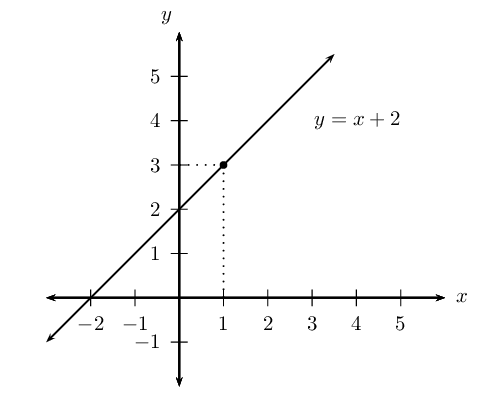
We can also have the situation where a function tends to a different limit depending on whether \(x\) approaches from the left or the right.
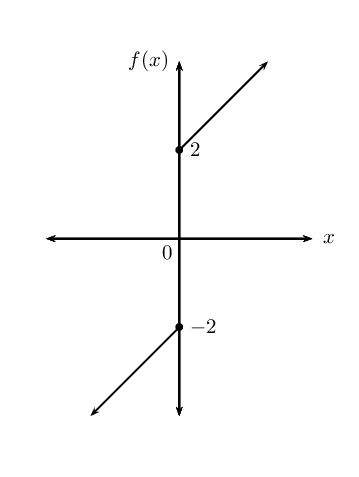
As \(x\to 0\) from the left, \(f(x)\) approaches \(-\text{2}\). As \(x\to 0\) from the right, \(f(x)\) approaches \(\text{2}\).
The limit for \(x\) approaching \(\text{0}\) from the left is:
\[\lim_{x\to {0}^{-}}f(x)= -\text{2}\]and for \(x\) approaching \(\text{0}\) from the right:
\[\lim_{x\to {0}^{+}}f(x)= \text{2}\]where \(0^{-}\) means \(x\) approaches zero from the left and \(0^{+}\) means \(x\) approaches zero from the right.
Therefore, since \(f(x)\) does not approach the same value from both sides, we can conclude that the limit as \(x\) tends to zero does not exist.
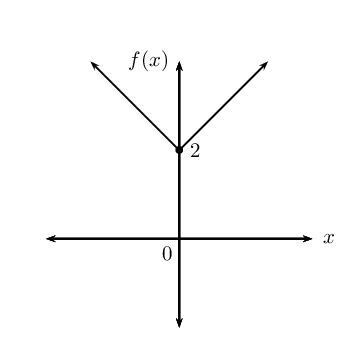
As \(x\) tends to \(\text{0}\) from the left, the function approaches \(\text{2}\) and as \(x\) tends to \(\text{0}\) from the right, the function approaches \(\text{2}\). Since the function approaches the same value from both sides, the limit as \(x\) tends to \(\text{0}\) exists and is equal to \(\text{2}\).
Determine:
Illustrate answers graphically.
We cannot simplify further and there are no terms to cancel.
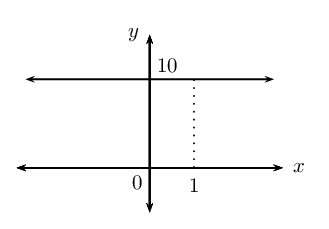

Determine the following and illustrate the answer graphically:
\[\lim_{x\to 10}\frac{{x}^{2}-100}{x-10}\]Factorise the numerator:
\(\frac{{x}^{2}-100}{x-10}=\frac{\left(x+10\right)\left(x-10\right)}{x-10}\)As \(x \to 10\), the denominator \((x - 10) \to 0\), therefore the expression is not defined for \(x=10\) since division by zero is not permitted.
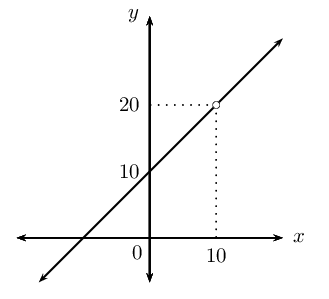
Determine the following limits and draw a rough sketch to illustrate:
\begin{align*} \lim_{x \to 3}\dfrac{x^2-9}{x+3} &=\lim_{x \to 3}\dfrac{(x-3)(x+3)}{x+3}\\ &=\lim_{x \to 3}(x-3)\\ &=3-3\\ &=\text{0} \end{align*}

\begin{align*} \lim_{x \to 3}\dfrac{x+3}{x^{2}+3x} &=\lim_{x \to 3}\dfrac{x+3}{x(x+3)}\\ &=\lim_{x \to 3}\dfrac{1}{x}\\ &= \frac{1}{3} \end{align*}
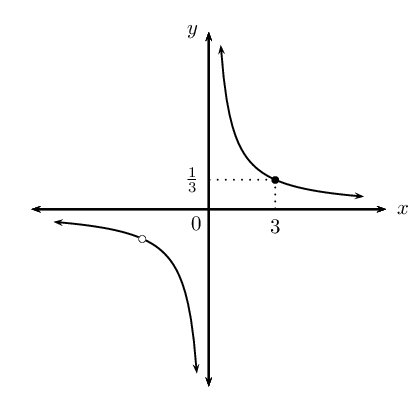
Determine the following limits (if they exist):
\begin{align*} \lim_{x \to 2}\dfrac{3x^2-4x}{3-x} &=\lim_{x \to 2}\dfrac{3(2)^2-4(2)}{3-2}\\ &=\lim_{x \to 2}\dfrac{12-8}{1}\\ &= \text{4} \end{align*}
\begin{align*} \lim_{x \to 4}\dfrac{x^2-x-12}{x-4} &=\lim_{x \to 4}\dfrac{(x-4)(x+3)}{x-4}\\ &=\lim_{x \to 4}(x+3)\\ &=4+3\\ &= \text{7} \end{align*}
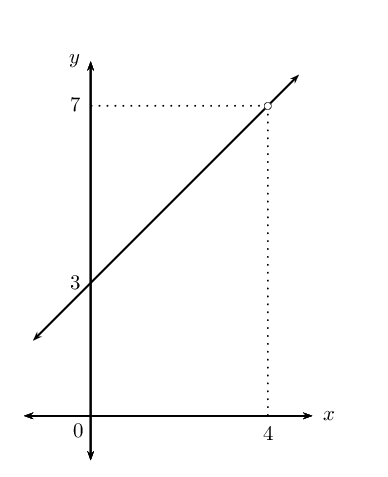
Important: notice that even though the function is not defined at \(x = 4\), the limit as \(x\) tends to \(\text{4}\) does exist and is equal to \(\text{7}\).
\begin{align*} \lim_{x \to 2} \left( 3x+\dfrac{1}{3x} \right) &=6+\dfrac{1}{6}\\ &= \frac{37}{6} \end{align*}
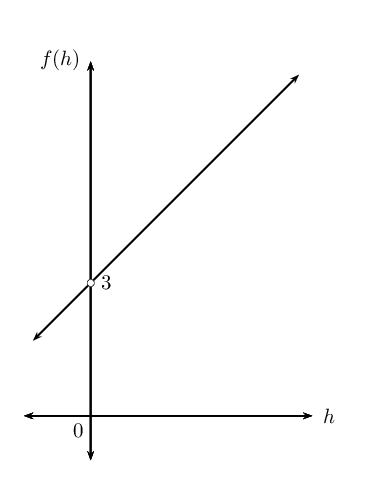
Even though the function is not defined at \(h = 0\), the limit as \(h\) tends to \(\text{0}\) does exist and is equal to \(\text{3}\).
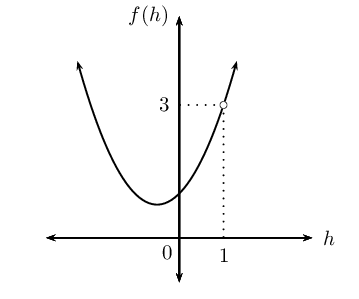
Even though the function is not defined at \(h = 1\), the limit as \(h\) tends to \(\text{1}\) does exist and is equal to \(\text{3}\).
Note that the function is not defined at \(x = 3\), but the limit as \(x\) tends to \(\text{3}\) does exist and is equal to \(\frac{\sqrt{3}}{6}\).
Average gradient
In Grade 11 we learnt that the average gradient between any two points on a curve is given by the gradient of the straight line that passes through both points. We also looked at the gradient at a single point on a curve and saw that it was the gradient of the tangent to the curve at the given point. In this section we learn how to determine the gradient of the tangent.
Let us consider finding the gradient of a tangent \(t\) to a curve with equation \(y=f\left(x\right)\) at a given point \(P\).
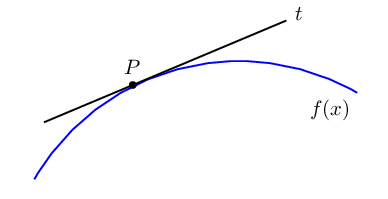
We know how to calculate the average gradient between two points on a curve, but we need two points. The problem now is that we only have one point, namely \(P\). To get around the problem we first consider a secant (a straight line that intersects a curve at two or more points) to the curve that passes through point \(P\left ( x_{P}; y_{P}\right)\) and another point on the curve \(Q \left( x_{Q}; y_{Q} \right)\), where \(Q\) is an arbitrary distance from \(P\).
We can determine the average gradient of the curve between the two points:
\[m = \frac{y_{Q} - y_{P}}{x_{Q} - x_{P}}\]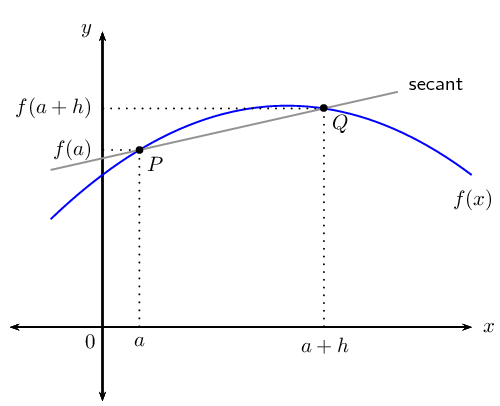
If we let the \(x\)-coordinate of \(P\) be \(a\), then the \(y\)-coordinate is \(f\left(a\right)\). Similarly, if the \(x\)-coordinate of \(Q\) is (\(a + h\)), then the \(y\)-coordinate is \(f\left(a + h\right)\).
We can now calculate the average gradient as:
\begin{align*} \frac{y_{Q} - y_{P}}{x_{Q} - x_{P}} & = \frac{f\left(a+h\right)-f\left(a\right)}{\left(a+h\right)-a} \\ & = \frac{f\left(a+h\right)-f\left(a\right)}{h} \end{align*}Gradient at a point
Imagine that \(Q\) moves along the curve, getting closer and closer to \(P\). The secant line approaches the tangent line as its limiting position. This means that the average gradient of the secant approaches the gradient of the tangent to the curve at \(P\).
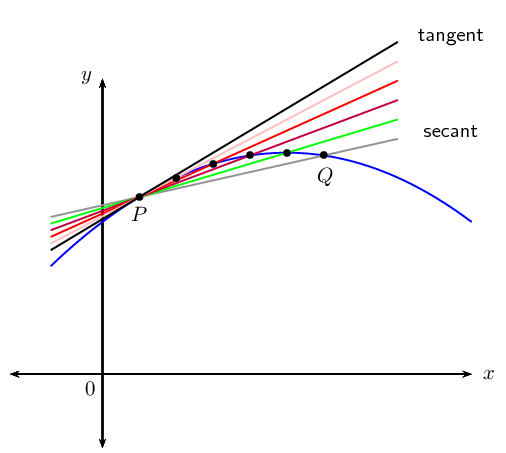
We see that as point \(Q\) approaches point \(P\), \(h\) gets closer to \(\text{0}\). If point \(Q\) lies on point \(P\), then \(h = 0\) and the formula for average gradient is undefined. We use our knowledge of limits to let \(h\) tend towards \(\text{0}\) to determine the gradient of the tangent to the curve at point \(P\):
\[\text{Gradient at point } P = \lim_{h\to 0}\frac{f\left(a+h\right)-f\left(a\right)}{h}\]Given \(g\left(x\right)=3{x}^{2}\), determine the gradient of the curve at the point \(x=-1\).
We need to find the gradient of the curve at \(x=-1\), therefore we let \(a = -1\):
\begin{align*} g(x) &= 3x^{2} \\ & \\ g(a) &= g(-1) \\ &= 3(-1)^{2} \\ &= 3 \\ & \\ g\left(a+h\right) &= g \left( -1+h \right) \\ & = 3{\left( -1+h \right)}^{2} \\ & = 3\left( 1-2h+{h}^{2} \right) \\ & = 3 - 6h + 3h^{2} \end{align*}Notice that we only take the limit once we have removed \(h\) from the denominator.
The gradient of the curve \(g\left(x\right)=3{x}^{2}\) at \(x=-1\) is \(-\text{6}\).
Given the function \(f\left(x\right)=2{x}^{2}-5x\), determine the gradient of the tangent to the curve at the point \(x=2\).
We need to find the gradient of the tangent to the curve at \(x=2\), therefore we let \(a = 2\):
\begin{align*} f(x) &= 2x^{2} - 5x \\ & \\ f(a) &= f(2) \\ &= 2(2)^{2} - 5(2)\\ &= 8- 10 \\ &= -2 \\ & \\ f\left(a+h\right) &= f\left(2+h\right) \\ & = 2{\left(2+h\right)}^{2}-5\left(2+h\right) \\ & = 2\left({2}^{2}+4h+{h}^{2}\right)-10-5h \\ & = 8 + 8h + 2h^{2} -10 -5h \\ &= -2 + 3h + 2h^{2} \end{align*}The gradient of the tangent to the curve \(f\left(x\right)=2{x}^{2}-5x\) at \(x=2\) is \(\text{3}\).
Determine the gradient of \(k(x) = -x^{3} + 2x + 1\) at the point \(x=1\).
Let \(a = 1\):
\begin{align*} k(x) &= - x^{3} + 2x + 1 \\ & \\ k(a) &= k(1) \\ &= - (1)^{3} + 2(1) + 1\\ &= - 1 + 2 + 1 \\ &= 2 \\ & \\ k\left(a+h\right) &= k\left(1+h\right) \\ & = - {\left(1+h\right)}^{3}+2\left(1+h\right) + 1 \\ & = - \left( 1 + 3h + 3h^{2} + h^{3} \right) + 2 + 2h + 1 \\ & = - 1 - 3h - 3h^{2} - h^{3} + 2 + 2h + 1 \\ & = 2 - h - 3h^{2} - h^{3} \end{align*}The gradient of \(k(x) = -x^{3} + 2x + 1\) at \(x=1\) is \(-\text{1}\).
Given: \(f(x) = -x^{2} + 7\)
\(\text{Graph:}\\ \text{Parabola: “frown” } (a < 0) \\ y_{\text{int}}: x = 0, y = 7 \\ x_{\text{int}}: y=0, x=\pm\sqrt{7} \\ \text{Turning point: } (0;7)\)
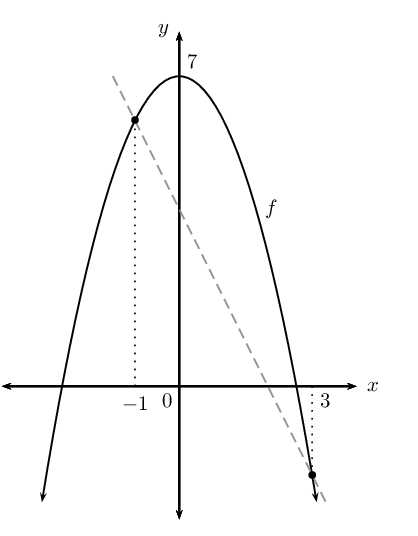
Determine the gradient of the tangent to \(g\) if \(g(x) = \frac{3}{x} \enspace (x \ne 0) \text{ at } x=a\).
To simplify the two fractions in the numerator, we get a common denominator \(x(x+h)\):
\begin{align*} &= \lim_{h\to 0} \frac{\frac{3(x)-3(x+h)}{x(x+h)}}{h} \\ &= \lim_{h\to 0} \frac{3x - 3x -3h}{h.x(x+h)} \\ &= \lim_{h\to 0} \frac{-3h}{h \cdot x(x+h)} \\ &= \lim_{h\to 0} \frac{-3}{x^{2}+xh} \\ &= \frac{-3}{x^{2}} \\ \therefore \text{Gradient at } x &=a \text{ is } \frac{-3}{a^{2}} \end{align*}Determine the equation of the tangent to \(H(x)=x^{2}+3x \text{ at } x=-1\).
The tangent meets the graph of \(H\) at \((-1;y)\)
\[\therefore y = (-1)^{2} + 3(-1) = -2\]Therefore tangent \(\) goes through \(H(-1;-2)\).
\begin{align*} y - y_{1} &=m(x - x_{1}) \\ \text{Substitute: } y - (-2) &=1(x - (-1)) \\ y + 2 &= x + 1 \\ y &= x - 1 \\ \therefore \text{Eqn. tangent at } x = -1 \text{ is } y &=x-1 \end{align*}|
Previous
End of chapter exercises
|
Table of Contents |
Next
6.2 Differentiation from first principles
|